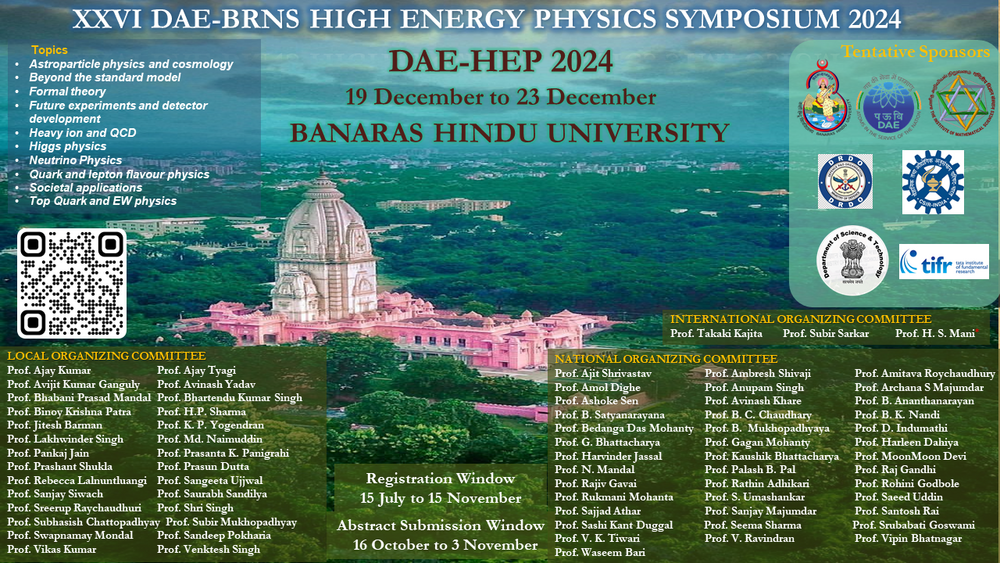Speakers
Description
To analyze atmospheric pressure effects on muon flux intensity related to meteorological factors over long periods provide valuable insights into the dynamics of space weather and climate change.
This study analyzes the relationship between muon flux and atmospheric conditions, specifically pressure, using data recorded since 2015 with portable detectors. Data have been collected from two configurations of muon detectors. The first configuration includes two plastic scintillators—one coupled with wavelength-shifting fibers and the other with a light guide—measuring 23.5 cm x 24 cm x 2 cm and 32 cm x 10 cm x 2 cm, respectively. In the second setup, both detectors are plastic scintillators with wavelength-shifting fibers, each measuring 23.5 cm x 24 cm x 2 cm. Both configurations have been oriented vertically for data collection. The solid angle between two detectors in the first assembly is 0.06 sr, and for the second assembly of muon detectors is 0.15 sr. The distance between the detectors is 15 cm in each of the set up[2].
This experiment has been conducted at Dayalbagh Educational Institute in Agra, where muon flux data were collected from the first setup in 2019, before Covid and from the second in 2022 post Covid. To assess correlations, the same two month comparison has been made between muon count rates and atmospheric pressure , from 2019 and 2022.
The analysis reveals a significant negative correlation between atmospheric pressure and muon flux. In 2019, the raw data indicated a pressure coefficient of -0.02/mbar and a correlation coefficient of $-0.50 \pm 0.11
$. applying correct data, the correlation coefficient improved to $-0.36 \pm 0.13
$. Similarly, in 2022, raw data presented a pressure coefficient of -0.14/mbar and a correlation coefficient of $-0.49 \pm 0.11
$. After data corrections, the correlation strengthened significantly, reaching $-0.96 \pm 0.01
$. In 2019, the initial raw data indicated a pressure coefficient of -0.02/mbar and a correlation coefficient of -0.50. After applying data corrections, the correlation coefficient improved to $-0.36 \pm 0.13
$. Similarly, in 2022, raw data presented a pressure coefficient of -0.14/mbar and a correlation coefficient of $-0.49 \pm 0.11
$. After data corrections, the correlation strengthened significantly, reaching $-0.96 \pm 0.01
$.
The measured value of relative Muon flux intensity for the two months in the year 2019 range from -11 to 58, while 2022 data vary from -7.5 to 12.5. Can this fall in the muon flux intensity be due to the minimum solar activity in 2019 for the solar cycle 25 ? This lockdown has a significant effect on the atmospheric conditions in terms of the air pollution.
These findings suggest that pressure-corrected muon flux data are essential for accurate measurements and highlight potential implications for solar modulation, which influences cosmic ray intensity, particularly during periods of increased solar activity. This approach enriches the understanding of cosmic ray behavior, atmospheric effects, and their implications for climate studies[3].
References
[1.] Mubashir, A., et al. "Muon Flux Variations Measured by Low‐Cost Portable Cosmic Ray Detectors and Their Correlation With Space Weather Activity." Journal of Geophysical Research: Space Physics 128.12 (2023): e2023JA031943.
[2.] Bhatnagar, Sonali. "Polystyrene based scintillation detector studies in Astro particle Physics and medical physics." arXiv preprint arXiv:2401.14706 (2024).
[3.] Maghrabi, Abdullrahman H., Safia A. Alzahrani, and Aied S. Alruhaili. "The Role of Atmospheric Pressure, Temperature, and Humidity on Cosmic Ray Muons at a Low Latitude Station." International Journal of Astronomy and Astrophysics 13.3 (2023): 236-258.
| Field of contribution | Experiment |
|---|

